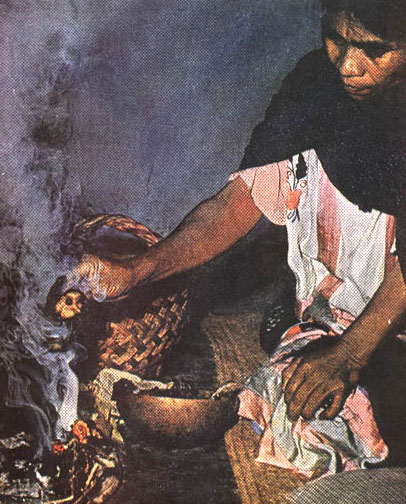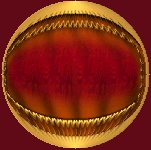Curanderos & Curanderas
(c) Cheryl Lynne Bradley 2007
Curanderos or Curanderas (the feminine form), are traditional Latin-American folk healers or shamans dedicated to healing the physical and spiritual illnesses of people. Curanderos are highly respected in their communities for their high levels of spirituality and religious belief. They often cure with herbs and traditional folk medicines but they are foremost supernatural healers who believe that many illnesses are a result of evil spirits sent as a punishment from God or from curses. They are often called on to treat people for shock, fright, malaise and the evil eye through the use of religious rituals, prayers and ceremonial cleansings. They use Icaros, or medicine songs, to contact a specific spirit to help them with the healing - each Icaro has a spirit associated with it. The Icaros are used and summoned during Ayahuasca ceremonies. The use of psychoactives like Magic Mushrooms and Peyote are common in indigenous shamanism.
Ayahuasca is largely used as a religious sacrament and is known for its hallucinatory and purgative qualities. It can bring about intense vomiting anad diarrhea which will cleanse the body of any parasites. Dietary restrictions are put in place before one can do an Ayahuasca ceremony, it is necessary to avoid fats, salt, caffeine and even sex before and after to avoid a hypertensive episode. The psychoactive ingredient in Ayahuasca is DMT (Dimethyltryptamine) which contains harmine alkaloids, originally called telephathine. Ayahuasca tourism is increasing popular. Companies organize tours and healing retreats into rainforest areas. These tours offer emotional and physical healing as well as communication with the spirit world. They are an introduction into a different cosmological and philisophical world. Wade Davis, the Canadian born anthropologist and author of "The Serpent and The Rainbow", wrote in his book "One River" describing Ayahuasca like this: "The smell and acrid taste was that of the entire jungle ground up and mixed with bile." [p.194]
Curanderos and Curanderas follow a tradition of knowledge that originated in Europe and is passed down orally from generation to generation. This has preserved important knowledge and cultural traditions. Curanderos usually fall into three categories: herbalists who try to cure with herbs; spiritualists who try to heal with prayer and mentalists who try to heal with their minds (mentalist healers are very rare). Like the storytellers of their culture, Curanderos are not chosen by distinct set of rules but by the mysterious connection of relationships and the handing down of traditional knowledge that will continue to grow in the chosen student to be used at the right time for the right reason. Curanderos do not charge a fee for their services but are given donations.
Maria Sabina was a famous Mazatec healer, curandera, and Shaman. She was a native of Huautla de Jimenez, in the State of Oaxaca, Mexico. She was born in 1896 and passed away on November 22, 1985 at the age of 91. She ingested Magic Mushrooms to see visions of the future, of other worlds and receive knowledge to help her heal her patient. She was discovered by a professor from Harvard in the 1950's and was featured in Life magazine. Rock stars became afficiandos and she was said to have told John Lennon of his death. She introduced the sacred mushroom ceremony called Velada to the world.
Veladas would have been conducted for various purposes including healing and were a group activity overseen by the Curandera/ Curandero or Shaman. All participants ingested Magic Mushrooms in varying quantities, the person leading the Velada would consume more.

Flowers, incense and candles were all used to bring colour , scent and energy to the ritual. The Magic Mushrooms were blessed, prayed over and purified with incense before ingestion. "I will take your blood. I will take your heart. Because my conscience is pure, it is clean like yours. Give me truth. May Saint Peter and Saint Paul protect me." The mushrooms were called "little children", "little things", "little saints" and "saint children". They were eaten and the candles would be extinguished to give a better atmosphere for the visions that would ensue. The visions would either send her forth to gather information or provide her the information she needed to perform a cure. Dance, chanting and drumming would also be part of the ritual.
Maria Sabina felt that she cured with the help of God, the "little saints", the Saints and Sacred Language. She also felt she paid a terrible price for sharing her knowledge with the world; her home burned down and her son passed away. In the last years of her life she stopped speaking the Mazatec language. She took very little for her cures, often accepting a pack of cigarettes or a few pesos for her work.
Curanderos methods of healing can conflict with modern medicine's idea of what a cure is. Curanderos healing and methods are often treated as worthless and superstitious by modern health care providers even. It cannot be overlooked though that herbal medicine has a long history and botany is an important aspect of medical research vital in the development of new pharmaceuticals. Curanderos are often discriminated against and called witches by modern doctors and non-cultural communities alike. In Latin American cultures, the supernatural is highly valued and this type of condemnation of the traditional methods has only succeeded in keeping people away from modern doctors. Some doctors have been wise enough to see the benefits of the spiritual and emotional healing offered by the Curanderos and work in conjunction with them to ensure the best of both worlds for their patients.
Metamorphosis: A Documentary on Ayahuasca Shamanism by Keith Aronowitz

















